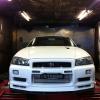Project Bnr32 - Powertune Australia Built
Announcements
-
Similar Content
-
Latest Posts
-
The downside of this is when you try to track the car, as soon as you hit ABS you get introduced to a unbled system. I want to avoid this. I do not want to bleed/flush/jack up the car twice just to bleed the f**kin car.
-
But again, the engineers said your cast aluminium would be fine based on the load that would be stretching that section. Same load stretching the bolts in a flex (not the twist), with a much smaller cross sectional area than the original part you've broken. It's why you'd need to be using higher strength bolts, but that's just making up for the strength you lose with less area...
-
By Dose Pipe Sutututu · Posted
I am truly amazed someone on this planet was able to cycle the pump using a scan tool. I've always ghetto cycled them on Nissan 90s shit boxes by slamming the brakes and pulling the handbrake to agitate the rear wheels enough to cause a speed difference -
By joshuaho96 · Posted
I didn't actually try it at the time but a Launch X431 with the appropriate software licenses/upsell will have the ABS bleed function. The Consult II you can still find some old sets of equipment but they're really, really expensive: -
Well I'll start by saying I'm not an engineer. I am going to go with the KiwiCNC ones. They are made of 7050 alloy have good fillets and radius. The material alone is in the order of double the strength and fatigue resistance - Those bolts, once torqued correctly place most of the load at the flat face of the mating surface - the 'stretch' you're talking about through torqueing them up would be far more than the extra stretch 'load' placed on them from a steering input or bump. (in my opinion) so I doubt they would flinch. - but again "not an engineer". oh and I don't think stitch welding 7050 is a good idea, likely just weaken the material (from what I read)
-





1.thumb.png.36afd656b26d55f5d425fc76e21561f2.png)




Recommended Posts
Create an account or sign in to comment
You need to be a member in order to leave a comment
Create an account
Sign up for a new account in our community. It's easy!
Register a new accountSign in
Already have an account? Sign in here.
Sign In Now